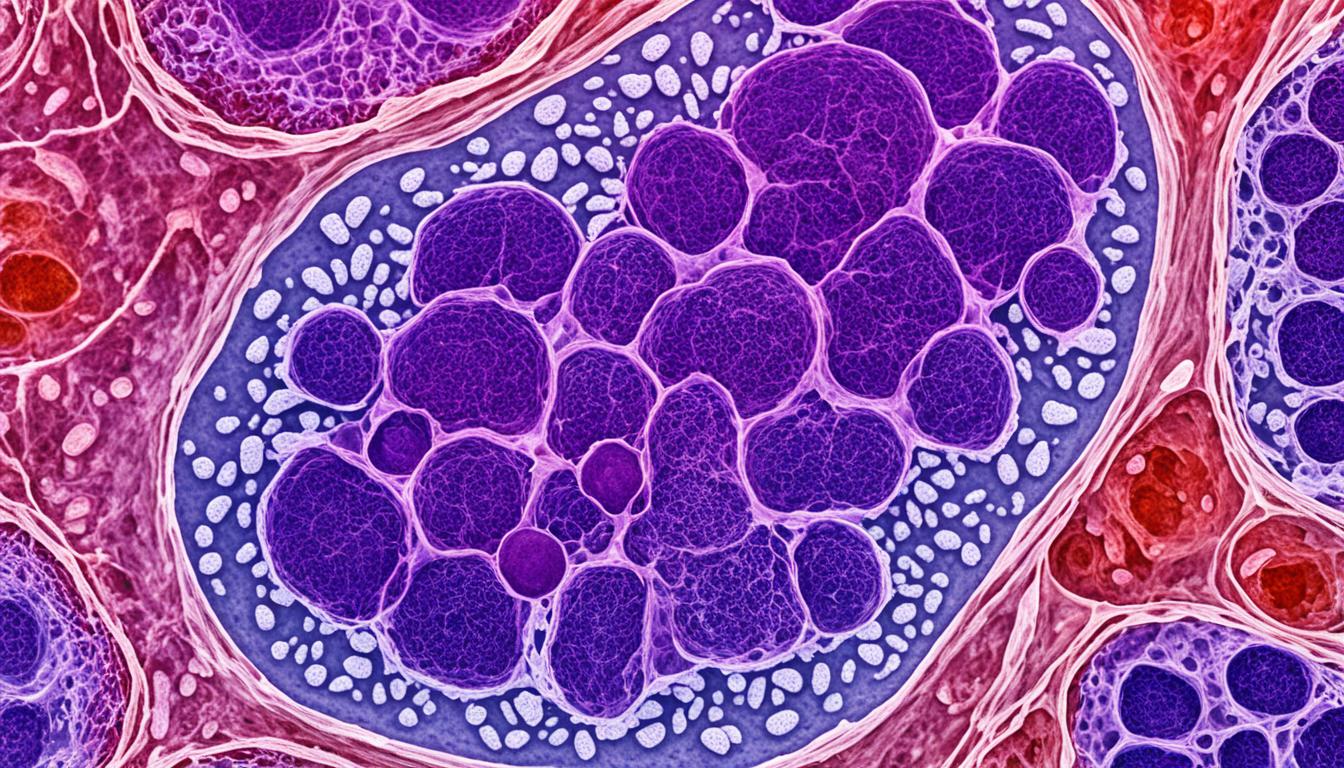Ductal carcinoma in situ (DCIS) is the first step of breast cancer. It happens when abnormal cells stay in the milk duct. DCIS is called stage 0 cancer or non-invasive cancer. Having DCIS increases the chance of getting real breast cancer later but it’s not dangerous by itself.
To find DCIS, doctors use mammograms which can spot changes in the breast. If something is noticed, they might do more tests like another mammogram or a biopsy to check the cells closely.
Treating DCIS can be through a lumpectomy, mastectomy, or therapy. A lumpectomy cuts out the area with DCIS plus a bit of healthy tissue. A mastectomy removes the full breast.
Researchers are looking into stem cell therapy as a new way to treat DCIS. They aren’t sure how well it works yet but it could make treating DCIS better in the future.
Key Takeaways
- DCIS is the earliest form of breast cancer confined within the milk duct of the breast.
- Diagnosis of DCIS is typically done through mammogram screenings.
- Treatment options for DCIS include lumpectomy, mastectomy, radiation therapy, and endocrine therapy.
- Stem cell therapy is an innovative approach being explored for the treatment of DCIS.
- Early detection and prompt treatment can prevent the progression to invasive breast cancer.
Early Detection and Diagnosis of DCIS
Mammograms are key in catching and diagnosing DCIS early, which is the first stage of breast cancer. They use low-dose X-rays to find breast calcifications. These can show if there’s abnormal cell growth in the breast.
Diagnostic mammograms, including 2D and 3D types, give clear looks at the breast tissue. They help doctors see any issues better. This improved imaging lets them diagnose more accurately.
If something looks off, more tests or procedures may be needed. A core needle biopsy is one way to do this. It involves inserting a special needle to collect tissue for closer examination. This test helps find and understand abnormal cells in the breast.
Doctors might also do an ultrasound-guided breast biopsy or a stereotactic breast biopsy to study abnormal tissue further. These methods help pinpoint and sample unusual cell growth. Then, doctors can better plan how to treat it.
Mammogram vs. Diagnostic Mammogram
Regular mammograms and diagnostic mammograms serve different purposes. A mammogram is a routine check. If it shows something unusual, a diagnostic mammogram is done for a closer look. This detailed test helps in the precise diagnosis of DCIS.
Advances in Mammography Technology: 2D vs. 3D Mammograms
Technology has led to 3D mammograms, or digital breast tomosynthesis. They provide a better, three-dimensional view than the older 2D mammograms. This improved view means fewer mistakes in diagnosis. It helps catch DCIS early and guides better treatment.
Summary
Spotting and diagnosing DCIS early is critical. Mammograms, especially diagnostic ones, are a big help. They lead to more tests like biopsies, which confirm DCIS. This all sets the path for the right treatment.
Treatment Options for DCIS
The type of treatment for ductal carcinoma in situ (DCIS) depends on what the biopsy shows and other factors. Here are the main options:
Lumpectomy (Breast-Conserving Surgery)
Lumpectomy is a common choice for DCIS. It removes just the part of the breast with DCIS and a bit of healthy tissue. This keeps the breast looking as normal as possible while getting rid of cancer cells.
Radiation Therapy
After a lumpectomy, you might need radiation therapy. It helps lower the chance of the cancer coming back. High-energy rays are used to kill any remaining cancer cells. Treatments are short and happen daily for a few weeks.
Mastectomy
In some situations, a mastectomy might be suggested. This surgery removes the entire breast. Doctors might choose this if the DCIS is in multiple spots or for cosmetic reasons. It’s a more thorough approach for some patients.
Hormone Therapy (Endocrine Therapy)
Hormone therapy is for those with DCIS that’s estrogen receptor (ER)-positive. It lowers the risk of the cancer returning or spreading. Medicines like tamoxifen or aromatase inhibitors stop estrogen from helping cancer cells.
It’s key for any DCIS patient to talk fully with their care team about treatment choices. You should understand the pros and cons of each. Your pick should match your own situation and what you’re most comfortable with.
| Treatment Option | Description |
|---|---|
| Lumpectomy (Breast-Conserving Surgery) | Removal of the area affected by DCIS and a small amount of surrounding healthy tissue |
| Radiation Therapy | Use of high-energy rays to destroy remaining cancer cells after a lumpectomy |
| Mastectomy | Complete removal of breast tissue |
| Hormone Therapy (Endocrine Therapy) | Medications to block the effects of estrogen on cancer cells in ER-positive DCIS |
Conclusion
Ductal carcinoma in situ (DCIS) is an early form of breast cancer. It is non-invasive and can be found through mammogram screenings. Early discovery is very important. It helps manage DCIS well and stop it from becoming invasive.
Treating DCIS has various options. These include lumpectomy, mastectomy, radiation, and endocrine therapy. Lumpectomy takes out the area with DCIS but saves most of the breast. Mastectomy removes the whole breast. Radiation helps lower the risk of it coming back if you had a lumpectomy.
There is also research on how stem cell therapy might help with DCIS. Stem cells can become many different cells. This might lead to new ways to heal and do better with the disease. Though, more studies are needed to be sure of its benefits.
If you or someone you know has DCIS, working closely with healthcare experts is key. They can help choose the best plan for your situation. Screening often and starting treatment soon can make a big difference. Early steps and working together are essential for handling DCIS well.

